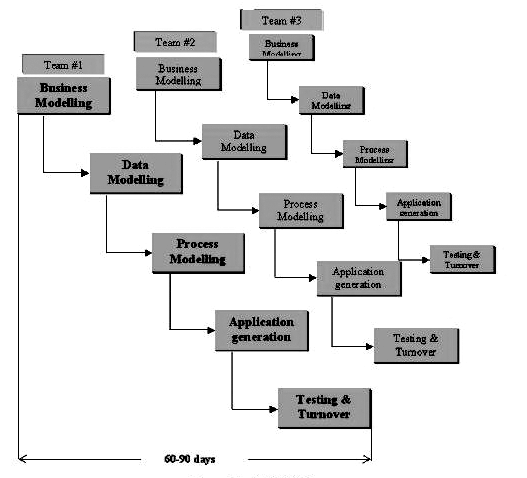Introduction to software development life cycle (SDLC)
Chapters
Rapid Application Development (RAD) Model
The Rapid Application Development (RAD) has not specific planning involved and is same as the iterative and prototype model. In this model the functions/components are developed simultaneously as if they were small projects. Rapid Application development mainly concentrates on gathering requirements through focus groups/workshops, prototypes early testing by the customer using iterative concept, the existing components/prototype can re-use and rapid delivery.
There is no pre-planning in this model hence can makes changes easier within the development process. Rapid Development projects follow incremental and iterative model and have small teams comprising of developers, customer representatives, domain experts and other IT resources working progressively on their prototype.
RAD Model Diagram:

The Rapid Application Development (RAD) model phases are:
- Business modeling: The information flow between various business functions.
- Data modeling: Information collected from business modeling, flow into a set of data objects that are needed for the business.
- Process modeling: The defined data objects in the data-modeling phase are transformed to get information flow that is needed to implement a function.
- Application generation: Process models convert into code and the actual system by using automated tools.
- Testing and turnover: Test new functionalities and the interfaces.
When to use RAD model:
- Suitable for to develop an application that can be modularized in short term i.e. 2-3 months.
- It should be used with high business knowledge resources to develop an application in short term i.e. 2-3 months.
Advantages:
- Requirement changes are allowed
- Initial reviews occur
- Reusability of components exists
- User can measure the progress
- Reduced development time.
Disadvantages:
- It requires skilled designers/designers.
- There will be dependency on strong technically team members for finding business requirements.
- Suitable for short term project.
- Dependency is high on modeling skills
- Application can be modularized which can be developed using RAD
In the next chapter, we will get some understanding of the Agile approach
Description
This tutorial covers
- What is SDLC
- Waterfall Model
- Spiral Model
- Prototype Model
- V-Model
- Iterative model
- Big Bang Model
- RAD Model
- Agile Model
- Useful resources to futher your understanding on SDLC
Report any errata directly using our support forms
Audience
Beginners looking to get their hands on understanding of software development life cycle (SDLC)
Learning Objectives
A quick introduction to SDLC
Author: Subject Coach
Added on: 30th Jul 2015
You must be logged in as Student to ask a Question.
None just yet!